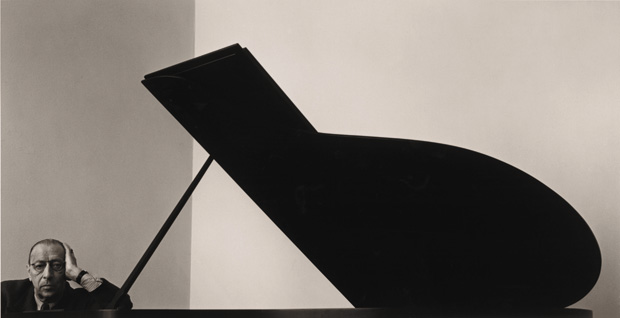Celebrity subjects, celebrated vision
Published December 19, 2012
Internationally renowned Jewish photographer Arnold Newman (1918 – 2006) thought of his work as an expression of himself. His statement might come as a surprise, considering he created insightful portraits of some of the most famous people who lived during the 20th century.
He elaborates on this idea in his book “Arnold Newman,” saying his work is a reflection of his “fascination with people, the physical world around us, and the exciting medium in which I work.”
The exhibition at the Sheldon Art Galleries, “Arnold Newman: Luminaries of the Twentieth Century in Art, Politics and Culture,” includes 60 portraits of artists, writers, scientists, political figures and architects. Each subject is depicted in an environment specific to them. Newman also captures the subjects’ personalities in their subtle facial expressions and body positions.
In the portrait titled “Martha Graham” (1961), the famous choreographer and dancer stands in front of a ballet bar attached to the wall in a New York dance studio. The baseboard and pictured section of ceiling run parallel to the bar, breaking up the image into three horizontal sections and creating an abstract quality. Graham’s dark hair is tied in a bun on the top of her head and she stares at the camera with the barest trace of amusement on her face. A long black cape falls from her shoulders to the floor, outside the frame. The image conveys drama and a sense of mystery.
Perhaps the most poignant image in the exhibition depicts Otto Frank, the father of Anne Frank. Newman photographed him in 1960 in Amsterdam’s Anne Frank House, where he and his family hid during the war. Frank survived the Holocaust but lost his wife and his daughters Anne and Margot. After the war, he came into possession of Anne’s writings and was able to publish her diary in 1947.
The portrait of Frank is dark in terms of lighting and also subject matter. He leans against a square post in the center of the room and wears a dark suit. An unseen light source from the right illuminates him and part of the room: a door to the right, stairs to the left, ceiling beams, and the floor. The image feels oppressive, almost claustrophobic, except for the light coming in. Newman uses lighting and the setting of the house to create a somber mood.
Newman studied art at the University of Miami in Florida in the late 1930s, and in 1938 he began working as a portrait photographer for companies in Florida and on the East Coast. Outside of work, he experimented with documentary and abstract photography.
During the early 1940s Newman exhibited his own work in shows in New York and Philadelphia. He became a successful portraitist and in 1946, moved from Florida to New York where he opened a studio and broke ground in the new field of environmental portraiture. He photographed his subjects with the items of their craft: architect Frank Lloyd Wright with design plans of a home; photographer Berenice Abbott with her camera; and composer Leonard Bernstein with sheet music in a concert hall, to name a few.
From the 1940s until his death in 2006, Newman’s success continued to grow exponentially. He wrote more than 13 books, published in the United States and other countries; his photographs and articles appeared in magazines such as Vanity Fair and The New Yorker; and Newman himself appeared on a number of television shows. Museums around the world have purchased his work. Between 1999 and 2003, five museums in the United States and Europe held retrospectives of his 60-year career.















